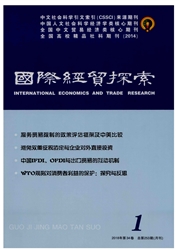

 中文摘要:
中文摘要:
基于2012年、2014年"一带一路"沿线65个国家的贸易数据,运用块模型及QAP等网络分析方法,对贸易网络结构及影响因素进行了分析。研究发现:(1)动态比较来看,"一带一路"战略实施以来,贸易网络的联系程度得到了显著提升,中国、印度、新加坡处于贸易网络的中心位置;(2)"一带一路"贸易网络可划分为四个贸易板块,中国等21个国家属于双向溢出板块,以色列等20个国家属于经纪人板块,阿富汗等16个国家属于主溢出板块,马尔代夫等8个国家属于主受益板块;(3)国家间的空间邻近关系、文化差异、贸易协定关系、贸易结构及制度差异对于贸易网络具有显著影响。
 英文摘要:
英文摘要:
This paper uses the trade data of 65 countries along "One Belt One Road" in the years of 2012 and 2014, employs block model and QAP methods to reveal the network structure and influence factors of trade network. The results show that: from the perspective of dynamic comparison, after the execution of the "One Belt One Road" initiative, the trade network has improved its connectivity significantly. China, India, and Singapore are at the central place in the network;( 2) The "One Belt One Road" " trade network can be divided as four trade plates. The first is "bidirectional spillover plate" composed of China and other20 countries, the second is " agent plate" composed of Israel and other 19 countries, the third is " main spillover plate " composed of Afghanistan and other 15 countries, and the fourth is "main beneficial plate" composed of Maldives and other 7 countries;( 3) The spatial proximity, cultural difference, trade agreement relationship, intra-industry trade relationship and institutional distance of countries have a significant impact on the formation of trade network.
 同期刊论文项目
同期刊论文项目
 同项目期刊论文
同项目期刊论文
 期刊信息
期刊信息
